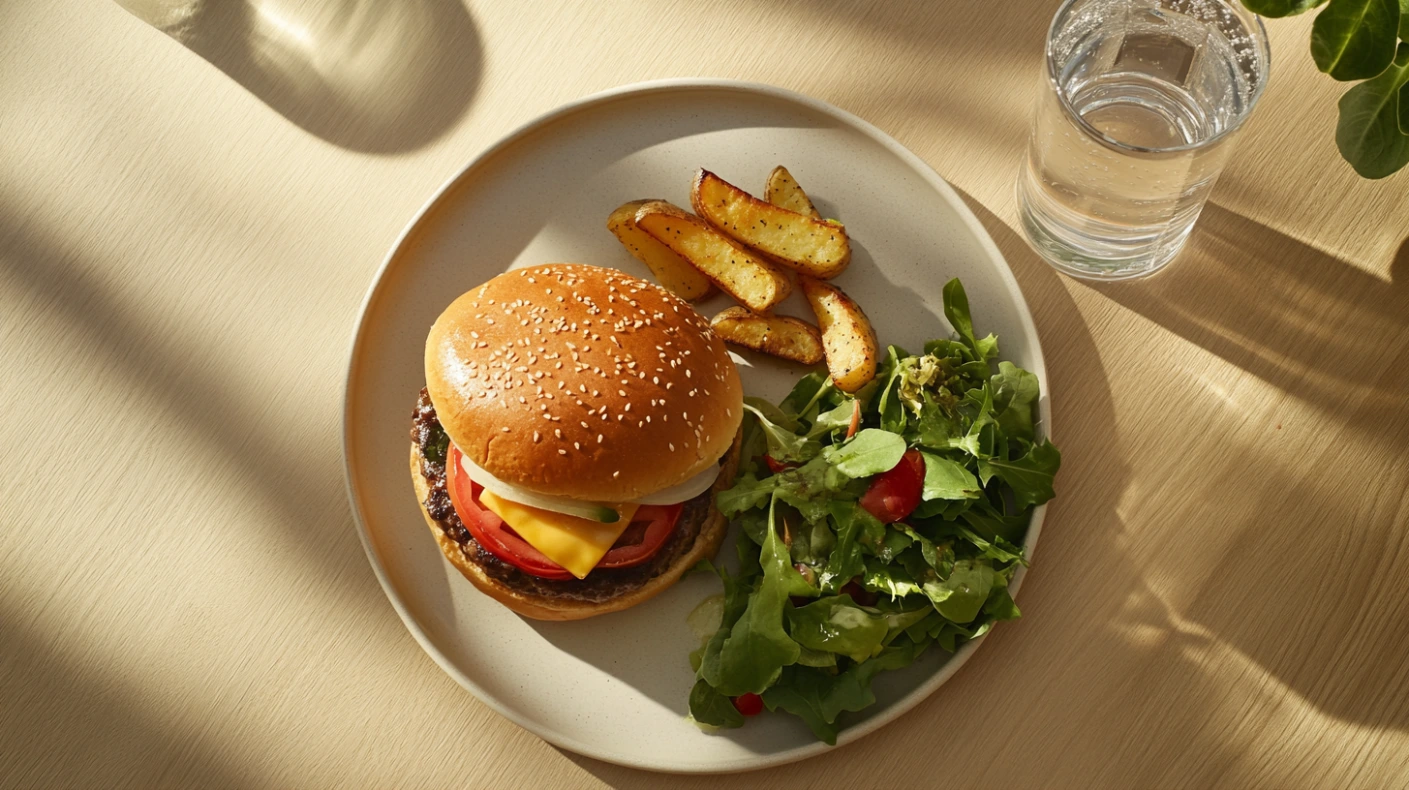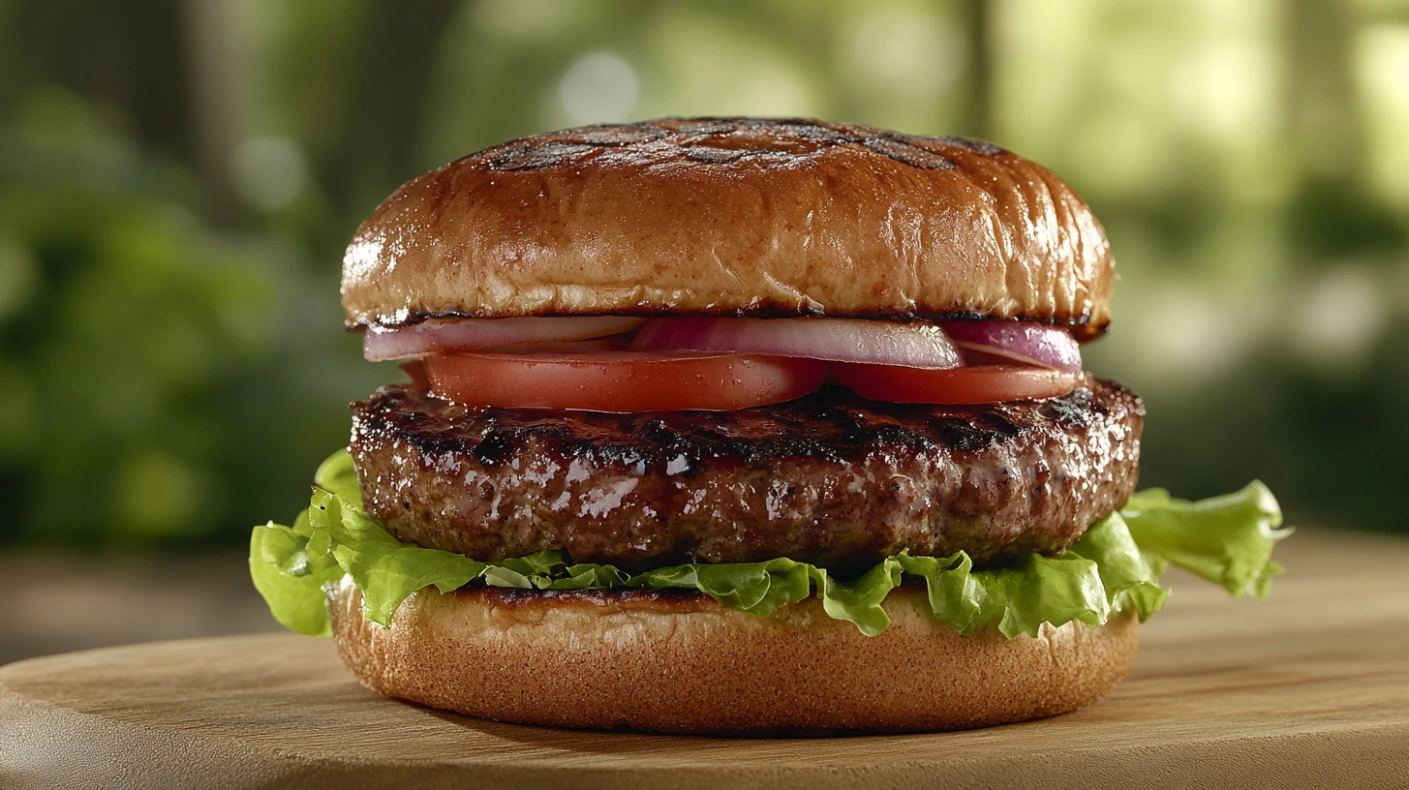Discover what is the healthiest way to eat a hamburger with tips on lean proteins, whole-grain buns, and nutritious toppings for a balanced meal.Hamburgers are a beloved meal worldwide, but they often carry the stigma of being unhealthy. What if you could enjoy this classic dish without compromising your health goals? This article dives into the healthiest ways to eat a hamburger, from choosing leaner patties and nutrient-dense buns to picking toppings that pack a nutritional punch. Whether you’re cooking at home or indulging at a restaurant, you’ll discover practical tips to turn your burger into a wholesome delight. Let’s begin!
Why Choose a Healthier Hamburger?
Understanding the Nutritional Basics of Burgers
Hamburgers combine essential nutrients like protein, iron, and zinc, primarily from the patty. However, traditional versions are often high in calories, saturated fats, and sodium. Balancing these nutrients while limiting the less desirable elements is the key to enjoying a healthier burger.
Common Health Concerns Associated with Traditional Burgers
Typical fast-food burgers can lead to issues like weight gain, high cholesterol, and elevated blood pressure due to excessive fats and refined carbs. Overindulging also increases your intake of unhealthy additives and preservatives, which can strain your long-term health.
Benefits of Eating a Healthier Hamburger
Switching to a health-conscious burger can help you maintain a balanced diet while still savoring a satisfying meal. By making smarter choices—like swapping refined buns for whole-grain ones or opting for lean patties—you can enjoy a delicious burger without guilt. Plus, nutrient-rich toppings add vitamins and fiber, supporting overall well-being.
Healthier Ingredients for the Patty
Choosing Lean Meat Options
The patty is the heart of every burger, so making a smarter choice here is crucial. Opt for lean cuts of beef like 90% lean ground beef or even ground turkey to cut back on saturated fats. Poultry alternatives are rich in protein yet lighter on calories. If you’re aiming for the healthiest approach, prioritize grass-fed beef for better omega-3 fatty acid content.
Exploring Plant-Based Alternatives
Plant-based patties are another way to transform a burger into a health-conscious meal. From black bean patties to those made with lentils, these options are packed with fiber and protein while being lower in fat. Brands like Beyond Meat and Impossible Burger offer patties with a taste and texture that mimic beef.
The Role of Seasonings and Fillers in Nutritional Quality
Spices and herbs can elevate the flavor of your burger without added salt or sugar. Think cumin, paprika, garlic, or oregano. To bind your patties, skip breadcrumbs and try almond flour or oat flour for a gluten-free, nutrient-dense alternative.
Health-Conscious Choices for Buns
Whole Grain Buns vs. Refined White Buns
One of the simplest ways to make a burger healthier is by switching to whole-grain buns. These are higher in fiber, which aids digestion and helps you feel full longer. In contrast, white buns often lack nutrients and can cause blood sugar spikes.
Low-Carb and Gluten-Free Options
For a lighter option, go for low-carb or gluten-free buns. These cater to specific dietary needs and are often made with almond or coconut flour, which add protein and healthy fats to the mix.
Creative Alternatives Like Lettuce Wraps
For the ultimate low-calorie option, ditch the bun entirely! Crisp lettuce wraps not only add a satisfying crunch but also boost your meal’s vitamin and mineral content. This simple swap can significantly reduce your carbohydrate intake.
Relevant recipes
- Burger Bowl Recipe – A creative twist on traditional burgers without the bun.
- How Many Calories Are in a Burger Bowl? – Learn the caloric impact of bun-free burgers.
Toppings That Add Nutritional Value

Vegetables: The Best Additions for Vitamins and Fiber
When it comes to toppings, vegetables are your best bet. Add slices of fresh tomatoes for a dose of vitamin C and lycopene, or stack on crunchy cucumbers for hydration and low calories. Leafy greens like spinach or kale bring iron, magnesium, and a wealth of antioxidants to the table. Don’t forget onions, which are rich in quercetin, a compound known for its anti-inflammatory properties.
Healthier Cheese Options
While cheese adds flavor, it can also add unnecessary fats. Opt for lower-fat versions of your favorites, like part-skim mozzarella or reduced-fat cheddar. Even better, try nutrient-rich alternatives like goat cheese, which is easier to digest, or feta, which has fewer calories. A little cheese goes a long way, so moderation is key.
Condiments to Choose or Avoid
Choosing the right condiments can transform your burger into a healthier meal. Instead of calorie-laden mayonnaise, go for avocado slices or Greek yogurt-based spreads. For added flavor, mustard and hot sauce are excellent low-calorie options. Steer clear of sugary ketchup or barbecue sauce, or opt for no-sugar-added varieties to keep your burger lean.
For more ideas on nutritious meal makeovers, check out our Burger Bowl Recipe, which creatively swaps out traditional burger elements for healthier options.
Cooking Methods for a Healthier Burger
Grilling vs. Frying: The Healthier Option
When pondering what is the healthiest way to eat a hamburger, how you cook it matters. Grilling allows excess fat to drip away from the patty, reducing overall fat content. Plus, it gives that smoky flavor without needing extra oils. On the other hand, frying can significantly increase calorie counts due to added fats.
Using Air Fryers or Baking for Reduced Fat
If grilling isn’t an option, air frying is a game-changer. Air fryers use minimal oil, delivering crispy, juicy patties with far fewer calories. Baking is another effective method, as it evenly cooks the patty while locking in moisture without adding grease.
Cooking Temperature and Food Safety
Always cook burgers to a safe internal temperature to avoid foodborne illnesses. For beef, aim for an internal temperature of 160°F (71°C), and for poultry, 165°F (74°C). A food thermometer ensures accuracy and safety, so don’t skip this step!
Healthy Sides to Pair with Your Burger
Choosing Baked or Air-Fried Potatoes Over Fries
Traditional French fries are tasty but often loaded with unhealthy fats and calories. Instead, opt for baked or air-fried potato wedges. These alternatives offer the same satisfying crunch but with far fewer calories and virtually no trans fats. Sweet potato fries are another fantastic option—they’re rich in vitamins A and C, providing a nutritious upgrade to your meal.
Adding a Side Salad
A fresh salad pairs wonderfully with a healthier burger. Toss together leafy greens, cucumbers, cherry tomatoes, and a drizzle of olive oil for a light yet satisfying side. Adding seeds or nuts, like sunflower seeds or almonds, can boost protein and healthy fat content. A side salad not only balances the meal but also increases your daily intake of vegetables.
Low-Calorie Beverages to Accompany Your Meal
When it comes to beverages, steer clear of sugary sodas. Instead, go for water infused with fruits, unsweetened iced tea, or sparkling water with a splash of lime. These choices keep the meal refreshing without adding empty calories.

For more delicious pairings and lighter meal ideas, check out our Healthy Buffalo Chicken Dip, perfect for complementing any casual meal.
FAQs About Eating Burgers Healthily
Can I Enjoy a Hamburger on a Diet?
Absolutely! The key is making thoughtful swaps and controlling portion sizes. Opt for lean meats, whole-grain buns, and nutrient-rich toppings. Understanding what is the healthiest way to eat a hamburger means balancing flavors with healthier ingredients.
What Is the Healthiest Fast-Food Hamburger?
Fast-food burgers can be enjoyed occasionally, especially if you choose options labeled “low-calorie” or “light.” Skip extra sauces and go for burgers with added veggies. Grilled chicken sandwiches can also be a better alternative.
Are Plant-Based Burgers Healthier Than Beef?
Plant-based patties are often lower in fat and calories, but it depends on the brand. Some are highly processed, so look for options with natural ingredients and a high fiber-to-fat ratio.
How Can I Cut Calories in a Hamburger Without Sacrificing Flavor?
Go bunless, choose leaner proteins, or use lighter condiments. Lettuce wraps, Greek yogurt spreads, and fresh veggie toppings all keep your burger flavorful yet healthy.
Summary and Recommendations
Quick Recap of Healthier Choices
So, what is the healthiest way to eat a hamburger? It’s all about making thoughtful swaps. Choosing lean protein for the patty, whole-grain buns, and fresh vegetable toppings can significantly improve the nutritional profile of your meal. Pairing your burger with a side salad or air-fried potatoes instead of fries makes the meal both satisfying and balanced.
Tips for Customizing Your Own Healthy Hamburger
To create your ideal healthy burger, start by focusing on quality ingredients. Experiment with plant-based patties, low-fat cheese, or even lettuce wraps for a unique twist. Don’t shy away from bold flavors like mustard, herbs, or hot sauce to enhance taste without piling on unnecessary calories.
Encouraging Moderation and Balance
Lastly, remember that balance is the secret to a healthy diet. Enjoying a burger occasionally as part of a nutritious, well-rounded meal plan can satisfy cravings while supporting your health goals. Small, mindful changes make a big difference over time.
Frequently Asked Questions (FAQs)
1. Can I Include Burgers in a Weight Loss Plan?
Yes! By following the tips outlined in this article, you can craft a lower-calorie burger that fits seamlessly into your weight loss plan. Swap high-calorie buns for whole-grain or lettuce wraps, and opt for lean proteins and fresh toppings.
2. What Are the Best Vegetarian Options for Burgers?
Vegetarian patties made from black beans, lentils, or chickpeas are excellent choices. They are packed with fiber and protein while being naturally low in fat. Look for recipes with minimal processing for the healthiest options.
3. How Often Should I Eat Hamburgers?
There’s no fixed rule, but moderation is essential. If you prepare them with nutrient-dense ingredients, burgers can be an occasional indulgence in a healthy diet. Pair them with lighter sides to maintain balance.
4. How Can I Reduce Sodium in My Burger?
To lower sodium, make your patty from scratch using fresh ingredients and minimal salt. Choose no-salt-added condiments and avoid processed cheeses. Loading up on fresh vegetables can further dilute sodium content in the overall meal.

